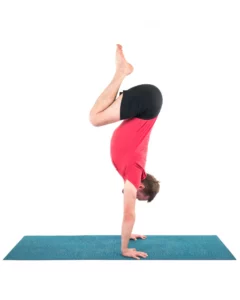Making Friends with Forward Bends: Strengthen and Stretch Your Back with Ardha Uttanasana

One of the reasons our yoga forward bends feel so good is that they stretch and lengthen our backs. That’s all well and good. However, it is also possible to overdo it and overstretch different structures along the back to the point that they lose their full contractile power and become “locked long” (get stuck in a lengthened state). Overstretching the posterior structures means that there will be less support coming from the back of the body, which can affect our posture and our ability to do any sort of activity that requires back strength (which is pretty much everything except for lounging on the couch).
How do we prevent this from happening?
Ardha Uttanasana: How to Prevent Overstretching in Forward Bends 
We need to make sure that we do enough spinal extension to balance it out.
Here we run into a bit of terminological confusion. We mostly think of “spinal extension” as bending back. But technically, “spinal extension” refers to the spine returning from the flexed position back to the neutral one, as well as bending back.
So when we say that spinal flexion (bending forward) needs to be balanced out by spinal extension, we mean both bending back and returning from the forward bend into the neutral-spine position. This is another reason why we lead with the chest when we come out of the forward bend, instead of rolling up. It gives us an opportunity to contract the same back muscles that we were stretching when we moved into the pose. This contraction increases circulation to the entire back and helps prevent overstretching of the supporting structures (like ligaments and fascia).
And we can take that strengthening and stabilizing effect one step further by combining Uttanasana (Standing Forward Bend Pose) and Ardha Uttanasana (Half Standing Forward Bend Pose). These two sister poses work very well together—in fact they complete each other! While Uttanasana stretches the structures of the back, Ardha Uttanasana strengthens them. As a result you get strong and supple back muscles. Here are some pointers on safer positioning in the postures.

How to Transition Between Uttanasana and Ardha Uttanasana
Here is how we do it:
Inhale: Raise the arms up
Exhale: Gradually contract the abdomen as you bend forward, keeping the knees soft and the chest elevated.
Inhale: Lift halfway up, extending the arms forward. Stay here for few breaths if you like, lengthening the spine on the inhalation and contracting the abdomen on the exhalation.
Exhale: Move back down, and relax the neck and shoulders. Stay here for few breaths, lengthening the spine slightly on the inhalation and contracting the abdomen on the exhalation.
Inhale: Lead with the chest and go all the way up.

Now the classic form of Ardha Uttanasana (with the arms extended forward) is quite strong and can be too much for the student’s back, shoulders or neck. Not to worry! There are many ways to adapt the form of this posture to make it work for you while putting less stress on the vulnerable areas. Think of those adaptations from the developmental standpoint. This is how you build back strength over time.

Use this progression to gradually strengthen the upper and lower back.
 Use this progression to emphasize one side of the back at a time, which is very useful when working with asymmetrical muscle development.
Use this progression to emphasize one side of the back at a time, which is very useful when working with asymmetrical muscle development.
Of course, you can also choose an adaptation that fits better with the theme of your class, or is more appropriate for specific students, and so on.

So there are two sides to the forward bending coin: some forward bends stretch your back structures, while others strengthen them. These two have to go hand in hand if you want to get more out of your forward bends and avoid overstretching.
Also, read...
Warrior I Pose: 5 Strengthening Variations
Deepening Your Home Yoga Practice: An Interview with Judith Hanson Lasater
4 Easy Ways to Use a Sandbag in Yoga Practice
Related courses
Breath as Medicine: Yogic Breathing for Vital Aging
Yoga and Myofascial Release: Releasing Chronic Tension with the Bodymind Ballwork Method

Educated as a school teacher, Olga Kabel has been teaching yoga for over 14 years. She completed multiple Yoga Teacher Training Programs but discovered the strongest connection to the Krishnamacharya/ T.K.V. Desikachar lineage. She had studied with Gary Kraftsow and American Viniyoga Institute (2004-2006) and received her Viniyoga Teacher diploma in July 2006, becoming an AVI-certified Yoga Therapist in April 2011. Olga is a founder and managing director of Sequence Wiz— a web-based yoga sequence builder that assists yoga teachers and yoga therapists in creating and organizing yoga practices. It also features simple, informational articles on how to sequence yoga practices for maximum effectiveness. Olga strongly believes in the healing power of this ancient discipline on every level: physical, psychological, and spiritual. She strives to make yoga practices accessible to students of any age, physical ability, and medical history, specializing in helping her students relieve muscle aches and pains, manage stress and anxiety, and develop mental focus.



